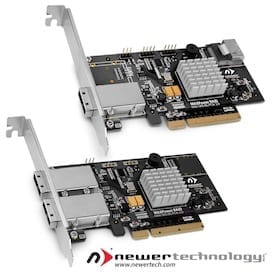 Newer Technology, Inc announced today its MAXPower RAID mini-SAS controller card line. Available in a choice of two external ports or one internal/one external port configurations, the MAXPower RAID mini-SAS cards provide full data transfer of four drives through a single cable connection for up to twice the data transfer speed offered by the SATA 2.0 (3Gb/s) data bus. Both versions of the MAXPower RAID mini-SAS controller card are available now form Other World Computing.
Newer Technology, Inc announced today its MAXPower RAID mini-SAS controller card line. Available in a choice of two external ports or one internal/one external port configurations, the MAXPower RAID mini-SAS cards provide full data transfer of four drives through a single cable connection for up to twice the data transfer speed offered by the SATA 2.0 (3Gb/s) data bus. Both versions of the MAXPower RAID mini-SAS controller card are available now form Other World Computing.
mini-SAS: More Lanes = Faster Speed
Just like a four-lane highway offers the fastest vehicle traffic flow, mini-SAS offers more “lanes” for data to travel at higher speeds. This interface offers the convenience of a one-cable connection but provides four separate channels so each drive can deliver its maximum data transfer rate. Now, with a MAXPower RAID mini-SAS controller card, one or more mini-SAS equipped external storage enclosures like the OWC Mercury Rack Pro can be utilized for greater speed, protection, or both; compared to single-channel, multi-drive eSATA RAID or eSATA Port Multiplier solutions.
Two Models Available
The MAXPower RAID mini-SAS 6G-2e card features two external mini-SAS ports that enable connecting and RAIDing multi-drive mini-SAS external enclosures or up to eight eSATA external enclosures via mini-SAS to eSATA breakout cables. For Mac and PC users who want to connect and RAID both external enclosures as well as internal drives, the MAXPower RAID mini-SAS 6G-1e1i card features one external mini-SAS port and one internal mini-SAS port
RAID Manager for Easy Array Management
The MAXPower RAID mini-SAS controller cards come complete with an easy-to-use, web browser-based utility that automatically logs all events that occur–from minor issues like inconsistent data to major issues like a failed drive. The built-in scheduling system offers quick convenience in setting up RAID arrays, managing connected drives, viewing storage health status and reviewing information about connected storage.
Key Features & Specifications
- High-speed PCIe 2.0 x8 bandwidth for up to 4GB/s data throughput (PCIe 1.0-compatible with reduced speed)
- Two mini-SAS ports:
- 1 x SFF-8088 external and 1 x SFF-8087 internal mini-SAS port (6G-1e1i model)
- 2 x SFF-8088 external mini-SAS ports (6G-2e model)
- SAS Expander support for connecting up to 128 SAS/SATA devices
- Multiple RAID level support: 0/1/5/10/50 and JBOD
- Hot plug and hot swap drive and solution support
- Automatic device pass-through to OS
- Easy-to-use browser-based NewerTech RAID Manager interface
- Storage Health Inspector (SHI) for monitoring and setting up reports, even via email, of array drives
- Compatible with SAS- and SATA-based hard drives and SSDs
“The MAXPower RAID mini-SAS controller cards offer the ultimate blend of performance and value in a PCIe mini-SAS RAID card,” said Grant Dahlke, Brand Manager, Newer Technology Inc. “Now Mac and PC owners can experience data transfer rate performance rivaling that of PCIe mini-SAS RAID cards that cost hundreds more.”
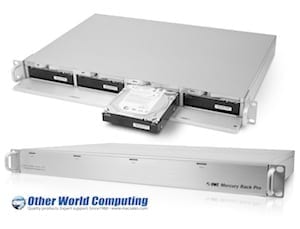
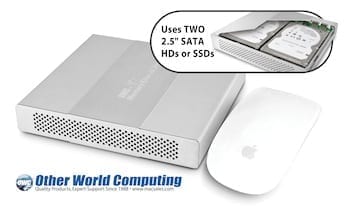
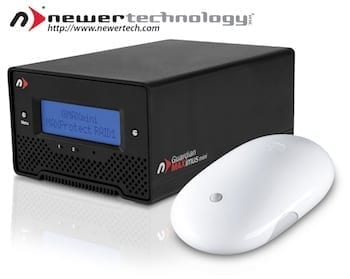

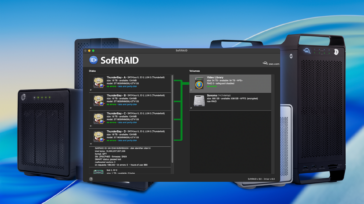
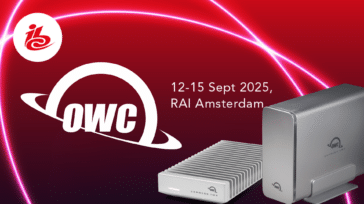



Hi guy been a long time OWC user….I have this Raid card and bunch of Drive from OWC along with my RAM…
Can you please upgrade the driver to work on Mac OS X Catalina….?
I upgrade my OS now i can’t install the driver for this card…say not support on Mac OS Catalina..I am stuck with 24TB RAID array hook uo to this card…now i can’t access it.
Thanks
Dara
Hi Dara! Sorry to hear about this. I would highly recommend that you contact Customer Support directly because you are experiencing issues while using OWC products. They are best equipped to troubleshoot any problems you are having.
U.S.A: 1-800-275-4576
International: +1-815-338-8685
Mon-Fri 8AM-8PM Sat 9AM-4PM
Online Customer Support: https://eshop.macsales.com/Service/
Hey Squishy…good to see you back again…right you are about bootability…although for our PC using friends, the card is bootable.How do these cards fare in the Mac Pro 1,1? If they show up as x8 properly in the x8, x1, x1, x16 configuration mode, I’ll gladly try it out. But I won’t buy until I know that bit of info. I have a Vertex 3 and my OWC SSD is in the mail to me today and I’d like to have a solution (MiniSAS 8088) for making full use of their speed. For now they’ll be JBOD, but I’ll be getting more Vertex 3s and will want to RAID 0 them.
Looks interesting! What about the Web Browser Raid Manager, does it need a constant internet connection or is it pretty much a onetime setup? We’re a little ways off the beaten path and my only internet access is through tethering!
I feel your pain, man. I’m in the exact same situation – tethering is my only access at home.
Fortunately, the Web Browser RAID Manager just allows you to access the card’s controls via a Web browser pointed to a localhost address. No Internet connection is necessary. You can access it whenever you want to.
Hi. I’m a professional photographer, working on 100gb folders of images every day. This card sounds great for my 5,1 MacPro. I’d be putting two 10K Velociraptor drives in an internal raid 0 for my working files and then an OWC 6G ssd for my system/applications. But if the card does not support booting, how could I put the ssd in bay 1 as my system/applications drive? And is there a way to have the internal SSD not go through the card but the other internal (and external) SATA drives go through it?
Thanks in advance for the info!
Hi Andy!
Unfortunately, this won’t quite work for the 09-10′s Mac Pros – but our engineers are in the process of putting together a solution for the later models. No eta…we’ll announce this when ready on blog…so stay tuned.
You could go external this route though:
– The Rack Pro mini-SAS 0GB unit http://eshop.macsales.com/search/OWCMRP1UMSAS
– Mini-SAS cable http://eshop.macsales.com/item/Micro%20Accessories/SAS450001M/
– MAXPower RAID mini-SAS 6G card – Get the 1e1i in anticipation of our solution and then have the capability to do both internal and external with the Rack Pro. http://eshop.macsales.com/search/MAXPower+mini-SAS
“Unfortunately, this won’t quite work for the 09-10′s Mac Pros – but our engineers are in the process of putting together a solution for the later models. No eta…we’ll announce this when ready on blog…so stay tuned.”
Have you designed or come up with a solution for using the “MAXPower RAID mini-SAS 6G-1e1i” card with the internal drives on a Mid 2010 5,1 Mac Pro?
Sleep mode compatibility with a mixed passthrough and RAID array is now confirmed. Disks show up on the desktop properly, at least for SSDs (which have no spin up time).
OK, finally got a second Vertex 3 120 GB SSD and have a RAID 0.
File copy of the InstallESD.dmg file took 6.25 seconds from the RAID 0 to a RAM disk (598.4 MB/sec)
File copy of the InstallESD.dmg file to the RAID 0 took 15.1 seconds (247.7 MB/sec)
File copy of the zero data test file from the RAID 0 to the RAM disk took 6.5 seconds (615.4 MB/sec)
FIle copy of the zero data test file to the RAID 0 from the RAM disk took 7.5 seconds (533.3 MB/sec)
Not double, but still significantly better than the JBOD scores, especially the incompressible data rate.
For fun I did a copy of the zero data file from the RAID 0 to the RAID 0 (direct copy on the same volume). That took 12.75 seconds (313.7 MB/sec). This is in line with what I expected as it pretty much becomes a full duplex transfer, thereby cutting the data rate in half since you’re going both from and to the same volume, and the total bandwidth of that volume is limited after all.
The oddball out is World of Warcraft – it takes just as long to load as in JBOD mode, which says something about the IOP limitations of even the SF-2200 controllers. I was hoping that WoW would load at least a bit faster, but zero improvement even in RAID 0 means that the small filesize reads (random 4k) is not enhanced by this card. I guess you’d need a read-ahead cache such as found on the higher end Areca cards for speeding that up. Sadly the Areca cards and my Mac Pro don’t seem to get along. At least the card I tried (1880ix-12).
It’s a real shame this card has no true EFI boot capability (it’s BIOS) – the OS would at least see some nice improvements from a RAID 0 environment. But for the price (and the apparently more stable driver than HPT’s counterpart(s)), it ain’t half bad.
And the auto-passthrough mode is nice too. Just make sure you name your Array without any white space in the name – the card balked at me when I tried to do so.
This card appears to be sleep compatible when using all passthrough (legacy) mode. I’m going to try getting another Vertex 3 120 GB SSD this week and seeing if a RAID array changes that.
OK, the NewerTech card does indeed work in my Mac Pro 1,1, with caveats.
Tests were done in JBOD mode (passthrough) to see what I could expect as a minimum for speed outside of a RAID. RAIDs would give greater speeds, though if these numbers are any indication, for a 1,1 Mac Pro, not much greater. See why below.
My test file:
InstallESD.dmg
3.74 GB on disk (3,743,009,943 bytes)
This is Mac OS X Lion’s installer .dmg file, the one embedded into the “disposable” installer Apple so lovingly gives us by default.
My “external” destination disk:
RAM Disk (4 GB)
The RAM Disk is created with the following command in Terminal:
diskutil erasevolume HFS+ “RAM Disk” `hdiutil attach -nomount ram://8192000`
File copy from OWC Mercury Extreme Pro 3G 40 GB SSD to RAM Disk: 29.8 seconds (125 MB/sec read…yech)
File copy to OWC Mercury Extreme Pro 3G 40 GB SSD from RAM Disk: 52.75 seconds (ouch!) 67 MB/sec (this number look familiar to you?)
File copy from OCZ Vertex 3 120GB SSD to RAM Disk: 10.75 seconds (344 MB/sec)
File copy to OCZ Vertex 3 120 GB SSD from RAM Disk: 27 seconds (137 MB/sec)
File copy from Intel 8O GB Gen 2 X-25M SSD (on internal SATA2 port) to RAM Disk: 14 seconds (264 MB/sec)
File copy to Intel 80 GB Gen 2 X-25M SSD (on internal SATA2 port) from RAM Disk: 46.75 seconds (79 MB/sec)
File copy from OWC Mercury Extreme Pro 3G 40 GB SSD to OCZ Vertex 3 120 GB SSD: 33.0 seconds (112 MB/sec)
File copy from OCZ Vertex 3 120 GB SSD to OWC Mercury Extreme Pro 3G 40 GB SSD: 50 seconds (74 MB/sec)
As you can see, these are pathetic numbers. Very pathetic numbers even for JBOD mode on a 6Gbps controller.
At x8 my total bandwidth, before overhead is 2.0 GB/sec on a PCI-E 1.0 slot such as the Mac Pro 1,1 has. Unless this also cuts each port’s speed from 6Gbps to 3Gbps as well, I should be getting twice these numbers in both read and write modes.
In fact, the Vertex 3 SSD is showing an abysmal 344 MB/sec sustained read from a single file. We’re not talking random 4k files here, we’re talking **one singular file 3.74 GB in size**. That’s royally craptastic considering this is on an SF-2200 controller capable of 550 MB/sec reads and 500 MB/sec writes.
RAM Disks can saturate a PCI-E 1.0 slot when transferring data across an x8 link width (it actually hits the 2 GB/sec wall easily). And since I’m copying to only one 6Gbps connection, which is 750 MB/sec max and getting these numbers, I’m really unimpressed.
Just to make sure I wasn’t going insane in the membrane, I re-ran the Vertex 3 -> RAM Disk copy test. Just a hair over 10 seconds for the copy to complete. That is about 370 MB/sec. Better than 344 MB/sec, but still nearly 180 MB/sec slower than the Vertex 3 is rated for.
Could it possibly be that the Mac Pro 1,1 just sucks that badly with RAID cards in general?
So from my experience so far with this card, it has potential, but which Mac Pro you use it in is going to make a huge difference. The good news is that the card is recognized properly at x8 in the slot utility’s x8, x1, x1, x16 configuration. The bad news is the above: very poor numbers.
The 67 MB/sec write copy test was a frustrating one. I had just returned an OWC 40 GB SSD because I couldn’t get >67 MB/sec writes to it in any OS on my Mac Pro’s internal bays. And now the RMA’d drive shows the exact same write speeds on both the internal HD bays and the new NewerTech card.
I wasn’t expecting massive performance like what I would see from an Areca 1880ix series card, but I was expecting to see my Vertex 3 do better than it did, even in JBOD mode.
The passthrough/legacy mode is just as the manual and website state: Plug and Play. In fact the drives show up with regular Mac style HD icons instead of the usual SCSI disk icons (the orange ones with the white SCSI logo). That’s a nice thing to have, even if it is a “little thing”.
My next set of tests will involve World of Warcraft, a game notorious for its insane number of small read/writes. We’ll see if the card can improve upon the SATA2 internal HD bays of the Mac Pro 1,1 in real world use.
An update:
I realized (rather late) that I was using what is known as an incompressible data type. That is, the .dmg file is already compressed and can’t be compressed further to enhance read/write rates.
So I then created two 2 GB dummy files (2000 MB each) and then concatenated them via Terminal (dd can’t create files larger than 2 GB in size, but you can use the ‘cat’ command in Terminal to combine them to make one ginormous 4 GB file).
Test file: test.txt (all zero data; fully compressible – best case scenario); 4 GB (4000000000 bytes)
I then did a file copy test to my SSDs. Here’s how it went:
File copy from RAM Disk to OWC Mercury Extreme Pro 3G 40 GB SSD: 17.25 seconds (231.8 MB/sec)
File copy from OWC Mercury Extreme Pro 3G 40 GB SSD to RAM Disk: 17.0 seconds (235.3 MB/sec)
File copy from RAM Disk to OCZ Vertex 3 120 GB SSD: 9.75 seconds (410.2 MB/sec)
File copy form OCZ Vertex 3 120 GB SSD to RAM Disk: 10.25 seconds (390.2 MB/sec)
File copy from RAM Disk to Intel 80 GB Gen 2 X-25M SSD on SATA2 port: 52.5 seconds (76.2 MB/sec)
File copy from Intel 80 GB Gen 2 X-25M SSD to RAM Disk: 15.8 seconds (253.2 MB/sec)
File copy from OCZ Vertex 3 120 GB SSD to OWC Mercury Extreme Pro 3G 40 GB SSD: 18.0 seconds (222.2 MB/sec)
File copy from OWC Mercury Extreme Pro 3G 40 GB SSD to OCZ Vertex 3 120 GB SSD: 18.15 seconds (220.4 MB/sec)
Now we’re getting somewhere. So while the Mac Pro model used with this card will likely influence data read/write rates, what I had above (below?) for my first test run was likely a worst case scenario and I didn’t realize it because I was using a file that couldn’t be compressed any further, so it would be the “slowest possible case” scenario.
That being the case, this card should do very well for those looking to make a RAID, as you’re going to see numbers 1.5-2x faster than either scenario respectively in RAID 0.
I’m glad I sat down and took another look at what I was doing and remembered OWC’s postings regarding incompressible data
So there ya have it. A worst case scenario and a best case scenario for JBOD functionality using two commonly used (and preferred) SSDs. You can expect the OWC Electra 6G SSDs to fare on par with the OCZ Vertex 3 as they use the same firmware and SandForce controller. Expect slightly higher speeds for the OCZ MAX IOPS line and OWC’s Mercury Extreme Pro 6G line as those are equivalants.
I can’t wait to get my next paycheck so I can pay off my cards and get another Vertex 120 GB SSD.
NOTE: The 240 GB+ versions from OWC and OCZ will have still better speeds, as their IOPS are higher than the 120 GB variants this time around, just like what happened with the SF-1200 based SSDs from OWC/OCZ.
Our product development team started reproducing your original data and came to the same conclusion that the incompressible data used was the reason for the slowdown. Glad everything worked out.
Many folks would like a bootable Raid 0 solution for SATA III SSD’s for the Mac Pro. Is there any chance of an integrated solution like OCZ’s RevoDrive 3×2 PCIe card in the future?
I’m sorry, but we can’t divulge information regarding the feasibility, development status or projected release date of future products.
When we do come out with new products, they will always be announced here on the OWC Blog right away, so bookmark us to be among the first informed on new products from OWC and Newer Technologies.
Now the only thing remaining is this:
On my Mac Pro 1,1 with a slot configuration of x8, x1 x1, x16 the Areca 1880ix-12 would only show up as an x4 card even though it was an x8 card, but in slot configuration x4, x4, x8, x8 and the Areca card in slot #2 (the first x8 in that list) the card shows up as x8.
How do these cards fare in the Mac Pro 1,1? If they show up as x8 properly in the x8, x1, x1, x16 configuration mode, I’ll gladly try it out. But I won’t buy until I know that bit of info. I have a Vertex 3 and my OWC SSD is in the mail to me today and I’d like to have a solution (soon) for making full use of their speed. For now they’ll be JBOD, but I’ll be getting more Vertex 3s and will want to RAID 0 them.
They fare well…reports as PCIe 1.o x8….thing is you have to make sure to check your slot configuration utility to make sure the card is in the appropriate slot and that slot is configured for x8
Right now the only options for booting, especially internally, are HighPoint (ugh), ATTO, CalDigit, and Areca. HPT is…well, they have solid hardware, lackluster drivers. ATTO is middle of the road with good drivers but limited feature sets. CalDigit has more flexibility in RAID modes and is a higher end card, but lacks user upgradeable cache RAM. Areca is expensive as hell, but you get what you pay for – true 6Gbps, multiple SAS (internal/external) ports, and 1-4 GB of DDR800 ECC RAM, user upgradeable on the higher end models.
But if you don’t need bootability and aren’t worried about needing a large cache (especially handy for media files), then this card may well be the best bang for the buck. It’s UI certainly looks more refined (and without broken English) than HPT’s MRAID manager. The auto-legacy/passthrough mode is quite nice as well.
My only question on this card is what controller chipset does it use for the drives? There are certain Marvell chipsets that act in x1 mode only, even with multiple SATA/eSATA/SAS ports, and even though the card may be x4 link width, the Marvell controller(s) make multiple drives on the same channel a worse prospect than just using the Mac’s intenral drive bays.
Hey Squishy…good to see you back again…right you are about bootability…although for our PC using friends, the card is bootable.
The controller chipset is a Marvell 9485 that runs at 8x:
http://www.marvell.com/storage/system-solutions/assets/Marvell-88SE9485-9445-Product-Brief.pdf
Surprising that a modern RAID card wouldn’t support RAID 6; or by extention, RAID 60.
Hey Bill…thanks for comment. Need to realize that we were looking at delivering the most commonly used RAID settings for this card in order to hit a price/performance balance. PCIe mini-SAS cards that have our cards performance cost hundreds more. To add a processor (XOR engine) capable of doing the double parity calculations of a RAID 6 costs substantially more than that of one that can do RAID 5.
Great news! I wonder, though, about something that wasn’t mentioned here on the product page: can this be used to boot OS X (Lion)? Either in RAID-0 config or with single drive (which I suppose should work; the point of interest here is being able to use 6G drivers on Mac Pro 2010)?
Booting from the MAXPower RAID mini-SAS 6G card is not currently supported for Mac. On PC’s, BIOS booting to RAID is supported.